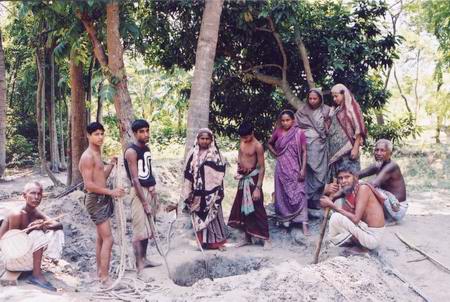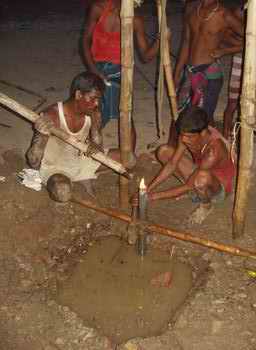The Devil’s Water
More than 90 percent of the people of Bangladesh are drinking groundwater but this water was always called the “Devil’s Water” by villagers and when tubewells were sunk in many districts, villagers left their villages crying out “the Devil’s Water” is coming, the “Devil’s Water” is coming. But this was quickly brushed aside as superstition. But today people ask - was it just superstition – because hundreds of thousands of people are now suffering from arsenicosis.
Why was it allowed to happen? This disease was not contagious. Instead it was caused by a classic case of solving one problem by creating another. When in the 1970s and ‘80s, UNICEF attempted to reduce the incidence of water-borne diseases by initiating a tubewell revolution which gave people access to underground drinking water, nobody bothered to test the water for arsenic. Like many others, they thought the water was safe. But it wasn’t because, although unknown at the time, many of these tube wells were tapping into groundwater that contained a slow, silent, killer - arsenic.
Today with an estimated 12-million tubewells in Bangladesh alone, many of which have levels of arsenic in the water above the World Health Organisation’s Safe Guideline recommendations, many people, even today, are drinking poisoned water, often because of ignorance, or apathy but also because they have no alternative. But with no known cure and the best treatment on offer – to drink arsenic-free water and eat a good nutritional diet – this for millions of villagers are still out of reach. We subsequently had to spend millions of dollars for testing tubewells for arsenic – which was a waste of money and time because these kits proved to be useless. Even the World Health Organisation and UNICEF no longer use them.
Arsenic is, as we know or should know by now, a naturally occurring compound, which is widely distributed throughout the earth. Trace levels can be found almost everywhere, in the air we breathe, in the soil, in the water and even in the food we eat. But the problem in Bangladesh is that the situation went out of control because the government of the day tried to hide it. They refused to believe that their people were at risk from arsenic poisoning because a geological survey that cost millions of dollars said the water was safe. But the survey never tested for arsenic as arsenic in this area was, they said, not a problem. How wrong they were! Dr D V Datta had already published a paper on arsenic in the UK Lancet that said many people in India are suffering from liver fibrosis, and he thought that maybe arsenic was the reason. He said, in many parts of India you should get arsenic in the groundwater but nobody thought about it, and worse, nobody continued the work he began. However he did manage to get the water from his parents’ village tested and in 1988 it was confirmed that there was an arsenic problem in West Bengal.
That being so, common sense would dictate that arsenic would be found in Bangladesh too but until 1995, the government continuously denied it and it took almost another eight years before they decided that there was indeed, arsenic in the groundwater despite the fact that many journals and many news items in several dailies, including this one, came out about this. That the issue was neglected would be an understatement. Today it is an unpleasant fact that the arsenic problem is not confined to West Bengal and Bangladesh but is spread right across the Indian sub-continent. But the worst seems to be in the Ganga Plain where the population of about 500-million risk their lives by drinking contaminated water. Although that does not mean that all will suffer, or all will continue to drink the water, but they are at risk. The problem is that even after more than fifteen years we are still in the dark and do not know just how big the problem really is. Meanwhile people fall sick and die.
Source: The Bangladesh Observer, June 11, 2006Top of page
Back to Project Report 2003
Women's Project
Home

